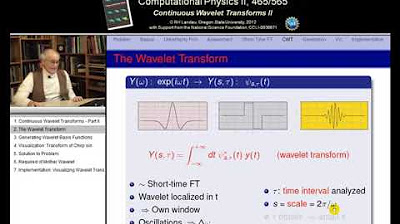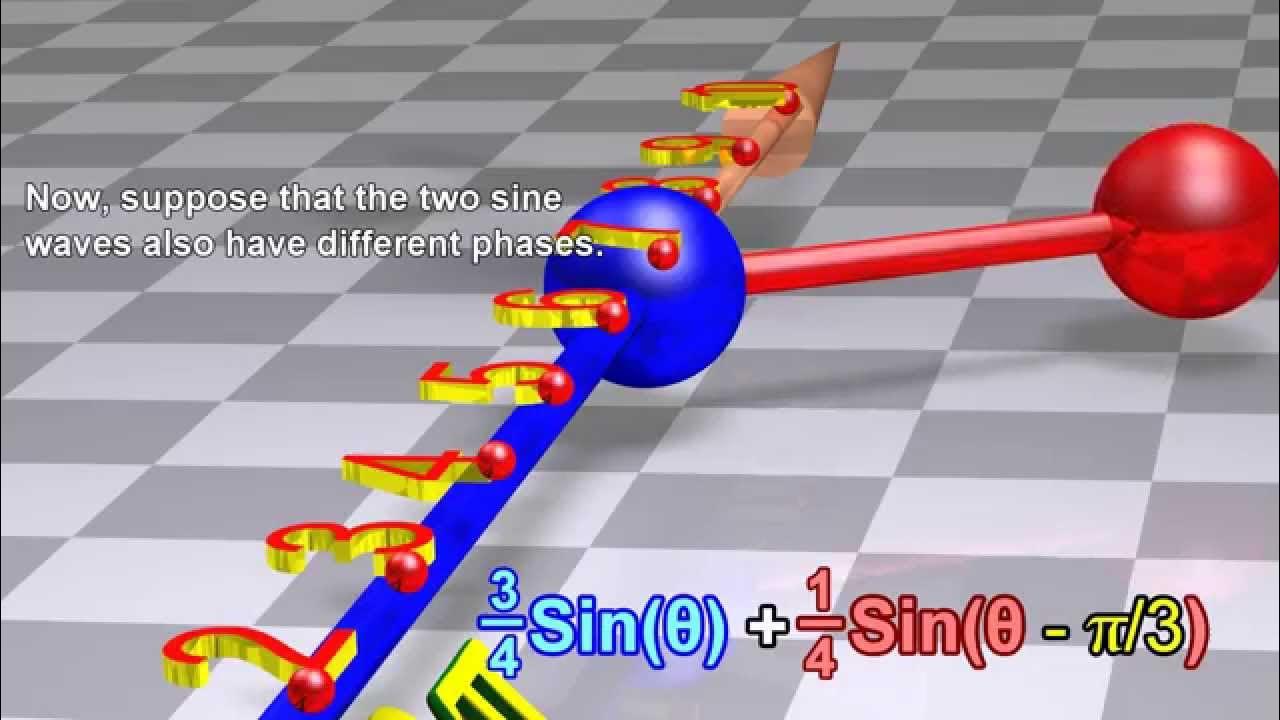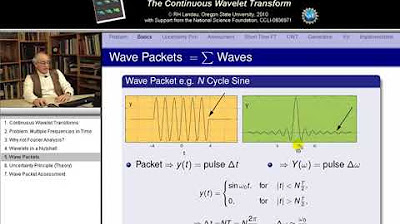But what is the Fourier Transform? A visual introduction.
TLDRThe video introduces the concept of the Fourier transform, a mathematical tool for decomposing signals into their constituent frequencies. It explains how wrapping a signal around a circle and analyzing its center of mass at different winding frequencies can reveal the original frequencies. The example of sound waves illustrates this, showing how complex signals can be broken down and filtered. The video also touches on the broader applications of Fourier transforms in various fields and hints at more advanced topics to be explored in future content.
Takeaways
- 🎵 The Fourier transform is a mathematical technique used to decompose signals into their constituent frequencies.
- 📊 The script introduces the concept by using the example of sound waves and their frequencies, such as the pure A note at 440 beats per second.
- 🥂 The idea extends beyond sound and frequency into various areas of math and physics, highlighting its ubiquity.
- 🌀 The process involves visualizing a signal's graph wrapped around a circle, with the winding frequency affecting the resulting shape.
- 🔄 The center of mass of the wrapped graph is key to identifying the signal's frequencies, with spikes in the transform corresponding to the original signal's frequencies.
- 📈 The 'almost Fourier transform' is a preliminary representation that shows the relationship between winding frequency and the center of mass's x-coordinate.
- 🎛️ The Fourier transform can be used to filter out unwanted frequencies, like an annoying high pitch in a sound recording.
- 🔄 The script also discusses the concept of Euler's formula and its relation to rotation and winding in the context of complex numbers.
- 🌐 The integral of a complex-valued function is used to find the center of mass of the wrapped graph, which is a step towards the full Fourier transform.
- 📏 The actual Fourier transform does not divide by the time interval, thus scaling the center of mass by the duration of the signal, emphasizing persistent frequencies.
- 🔮 The script concludes by mentioning that the Fourier transform has broader applications in math and promises deeper exploration in subsequent content.
Q & A
What is the main goal of the video?
-The main goal of the video is to introduce the concept of the Fourier transform and visually demonstrate its components and applications, particularly in the context of decomposing frequencies from sound.
How does the video illustrate the concept of frequency decomposition?
-The video illustrates frequency decomposition by using the example of sound waves, showing how a combination of pure frequencies can result in a more complex wave and discussing how to decompose this complex wave back into its original pure frequencies.
What is the significance of the pure A, 440 beats per second sound in the video?
-The pure A, 440 beats per second sound is used as a starting point to demonstrate the basic concept of frequency and how it can be combined with other frequencies to create more complex waveforms.
How does the video visualize the concept of wrapping a signal around a circle?
-The video visualizes the concept by imagining a rotating vector whose length corresponds to the height of the graph for a given time, thus creating a wound-up graph that can be analyzed as the vector rotates at different frequencies.
What is the role of the center of mass in the Fourier transform process?
-The center of mass plays a crucial role in the Fourier transform process as it helps identify the strength of a given frequency in the original signal. The center of mass's position changes depending on the winding frequency, and this change is used to detect the presence of specific frequencies in the signal.
How does the video explain the relationship between the winding frequency and the signal frequency?
-The video explains that when the winding frequency matches the frequency of the signal, the center of mass of the wound-up graph is unusually far to the right, indicating a strong presence of that frequency in the signal.
What is the 'almost Fourier transform' mentioned in the video?
-The 'almost Fourier transform' is a simplified version of the actual Fourier transform used in the video to illustrate the basic concept. It involves plotting the x-coordinate of the center of mass for different winding frequencies to identify the spikes that correspond to the original frequencies of the signal.
How does the video relate the Fourier transform to sound editing?
-The video relates the Fourier transform to sound editing by explaining that the transform can be used to identify and filter out unwanted frequencies in a sound recording. By applying the Fourier transform to the recording, one can pinpoint the frequencies that correspond to unwanted sounds and then reduce their amplitude to filter them out.
What is the significance of Euler's formula in the context of the Fourier transform?
-Euler's formula is significant in the context of the Fourier transform because it provides a mathematical way to describe rotation and winding. The formula is used to create complex exponential expressions that correspond to the rotation of a vector around a circle, which is a fundamental part of the Fourier transform process.
How does the video describe the final form of the Fourier transform?
-The video describes the final form of the Fourier transform as an integral of a complex-valued function over a time interval, which gives the center of mass of the wound-up graph. The transform is then scaled by the size of the time interval, with the integral part of this expression representing the actual Fourier transform.
What is the theoretical limit of the time interval in Fourier transform theory?
-In Fourier transform theory, the theoretical limit of the time interval is infinity. This means that the transform considers all possible finite time intervals and examines the limit of the expression as the time interval grows indefinitely.
Outlines
🎵 Introduction to Fourier Transform
This paragraph introduces the concept of the Fourier transform, a mathematical technique used to decompose signals into their constituent frequencies. It emphasizes the goal of providing an animated visual approach to understanding this fundamental idea from mathematics. The example of decomposing sound frequencies is used to illustrate the concept, highlighting the ubiquity of the Fourier transform across various fields such as math and physics. The paragraph sets the stage for a deeper exploration of how the Fourier transform can reveal the hidden frequencies within a complex signal.
📊 Visualizing Sound Frequencies
The paragraph delves into the specifics of how sound frequencies can be visualized using the Fourier transform. It explains the process of taking a pure frequency signal and wrapping it around a circle, with the length of a rotating vector representing the signal's intensity at different times. The discussion focuses on the center of mass of the wrapped graph and how it shifts with different winding frequencies. The key insight is that when the winding frequency matches the signal's frequency, the center of mass moves far to the right, indicating a peak in the signal. This visual representation forms the basis for the 'almost Fourier transform,' which is used to identify the frequencies present in a mixed signal.
🔄 Unmixing Frequencies
This section builds on the previous discussion by exploring the process of unmixing multiple frequencies in a signal. It describes how the almost Fourier transform can be used to identify individual frequencies within a complex waveform. The concept is illustrated by adding two pure frequency signals and showing how the winding frequency machine can reveal the original frequencies at 2 and 3 beats per second. The paragraph also touches on the property of the Fourier transform that allows for the addition of individual transforms to be equivalent to the transform of the summed signal, highlighting the practical applications of this mathematical tool in fields like sound editing.
🌀 Complex Numbers and the Fourier Transform
The paragraph introduces the use of complex numbers in the Fourier transform process. It explains that the center of mass of the wrapped graph is represented as a complex number with both real and imaginary parts. The concept of Euler's formula is introduced to describe rotation in the complex plane. The paragraph then presents a formula for winding up the graph, which involves an integral of a complex-valued function, representing the center of mass of the graph. The distinction between this 'winding machine' and the actual Fourier transform is clarified by noting that the latter does not divide by the time interval, effectively scaling up the center of mass by the duration of the signal.
🚀 Applications and Future Exploration
The final paragraph discusses the practical applications of the Fourier transform, particularly in sound editing, and touches on the concept of the inverse Fourier transform. It also hints at the broader implications of the Fourier transform in mathematics and physics. The video concludes with a mathematical puzzle from the sponsor, Jane Street, which serves as a teaser for future content and a call to action for viewers interested in mathematical problem-solving and career opportunities in quantitative trading.
📈 Career Opportunities in Math
This paragraph provides information about career opportunities at Jane Street, a quantitative trading firm that values intellectual curiosity and problem-solving skills. It mentions that the company is looking for both full-time employees and interns, and emphasizes that a background in finance is less important than one's ability to think critically and solve complex problems. The paragraph concludes with a call to action for viewers to learn more about Jane Street and apply for open positions.
Mindmap
Keywords
💡Fourier transform
💡frequency
💡decomposing
💡sound
💡winding frequency
💡center of mass
💡complex numbers
💡Euler's formula
💡integral
💡infinite time interval
💡3Blue1Brown
Highlights
Introduction to the Fourier transform, a fundamental concept in mathematics with extensive applications.
Exploration of how the Fourier transform can visually represent the components of complex signals, such as sound frequencies.
Explanation of the process of decomposing a mixture of frequencies into its pure frequency components.
Use of a rotating vector to visualize the pressure changes in sound waves as a function of time.
Demonstration of how the pressure vs. time graph of sound waves can be transformed into a more complex wave by combining multiple frequencies.
Discussion on the mathematical machine concept that treats signals of different frequencies differently.
Illustration of wrapping the graph of a signal around a circle to analyze its frequency components.
Explanation of the relationship between the winding frequency and the resulting graph's center of mass.
Introduction to the 'almost Fourier transform' and its ability to pick out specific frequencies from a signal.
Example of how the Fourier transform can be used to filter out unwanted frequencies in sound editing.
Discussion on the concept of the inverse Fourier transform and its role in reconstructing the original signal from its frequency components.
Explanation of the complex plane and its relevance to the Fourier transform, including the use of Euler's formula.
Description of the mathematical formula for winding a graph around a circle with a variable frequency.
Clarification on the difference between the 'almost Fourier transform' and the actual Fourier transform.
Explanation of how the Fourier transform scales with the duration of the signal's persistence.
Summary of the Fourier transform's function and output, including its real and imaginary components.
Note on the theoretical application of the Fourier transform over infinite time intervals.
Teaser for the next video discussing the broader applications of the Fourier transform in various areas of mathematics and physics.
Presentation of a mathematical puzzle related to convex sets, sponsored by Jane Street, a quantitative trading firm.
Transcripts
5.0 / 5 (0 votes)
Thanks for rating:





